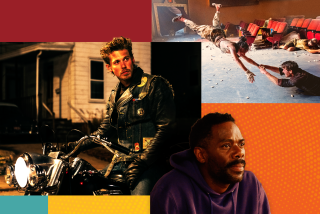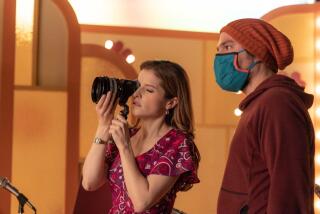Romance and Adventure in the Right Hands : ‘The Big Town’ Comes Out a Winner at All the Creative Games
- Share via
“The Big Town” (citywide) is so entertaining, so true to its period that it’s easy to peg it as another ‘50s nostalgia piece when it actually possesses the kind of complexity usually associated with less commercial, less starry productions. It is very much in the spirit that former Columbia Pictures Chairman David Puttnam said he wanted to bring to Hollywood.
The film also marks a terrific screen coming of age for Matt Dillon, who for the first time seems more man than boy, and it is a strong directorial debut for Ben Bolt, son of veteran screenwriter-playwright Robert Bolt. No element, however, is more impressive than Robert Roy Pool’s superlative script, adapted from Clark Howard’s novel “The Arm.”
It’s Dillon’s J. C. Cullen, a young man from Rockport, Ind., who’s got “the arm,” a knack for throwing dice, a skill that he has honed under the paternal tutelage of a crap shooter and auto mechanic (Don Francks), who pronounces him ready to try his luck in Chicago. He puts J. C. in touch with a woman named Ferguson (Lee Grant) and her blind, embittered husband (Bruce Dern), bar operators who also back gamblers for the lion’s share of the take. That’s OK with J. C., easily dazzled by the bright lights of Chicago in 1957. (Except for some establishing shots of Chicago, “The Big Town” was filmed in Toronto.)
Photographed with a keen sense of mood by Ralf D. Bode, “The Big Town” first of all brings alive the tremendous, intoxicating vitality of inner city night life that in most metropolitan areas is either a thing of the past or but a dangerous shadow of its former self. It captures the sense of fun and adventure that was then possible to indulge in without feeling you were risking your life. So much that’s lively at night in these days is either ultra-exclusive, not to mention ultra-expensive, or it’s for the very young. “The Big Town” brings back a more democratic era, a time when Times Square, for example, attracted people of all ages and walks of life in search of a good time.
Now, of course, anyone as handsome and cocky as J. C., even though he’s a good guy at heart, is going to get into some kind of trouble that will act as a rite of passage. He just can’t keep away from Diane Lane’s luscious Lorry Dane, a Lynn Bari look-alike and the headliner at the Gem Club, a striptease joint with a back room where the crap game is run by Lorry’s brutal husband Cole (Tommy Lee Jones).
What’s great about “The Big Town” is that it is so resolutely not just another shallow and sentimental loss-of-innocence tale told within a seductive evocation of a seemingly more innocent era. J. C. finds himself confronted with the ambiguity of human nature, which is a fancy way of saying that he discovers that generally nobody turns out to be all good or all bad.
It’s the unusually wide range of gradations within a whole gallery of people that gives “The Big Town” its substance and distinction: Ferguson is a tough dame but it’s an act of will; Suzy Amis’ Aggie really is a nice girl, which doesn’t mean she’s virtuous; Cole is vicious but not without a sense of humor; Tom Skerritt’s seasoned gambler, a real charmer, has done terrible things yet displays a gallant concern for J. C.; David Marshall Grant, another young gambler in Ferguson’s stable, seems just the folksiest, friendliest guy in the world, what with his hearty country-and-Western singer fiance (Cherry Jones), but is in fact a terrible bigot, and Lorry, it turns out, is not at all what she appears to J. C.
There’s a double-vision to “The Big Town” that puts it in a class by itself: We see all these people for ourselves and we also see them through the eyes of J. C., with his small-town ’57 sensibility and its simplistic morality.
There’s not a performance here that doesn’t ring true, nor is there a period detail that’s the least bit anachronistic in Bill Kenney’s production design and Wendy Partridge’s costumes. Aggie’s apartment, for example, doesn’t look like a Melrose window display of campy Atomic Age decor but shows ‘50s artifacts (e.g., the ubiquitous fake parchment tiered lamp shade) as merely additions to a nondescript traditional setting that looks basically unchanged since the ‘20s or ‘30s. Even the oldies-but-goodies sound track shows understatement in its selection: There’s no Elvis, and the familiar songs are not always heard in their most familiar versions.
It’s hard to imagine anyone who was J. C.’s age in 1957 not being thoroughly captivated by “The Big Town” (MPAA-rated R for some non-exploitative sex and violence). You needn’t have turned 21 three decades ago to enjoy this film, but there’s no denying that it helps.
‘THE BIG TOWN’ A Columbia Pictures presentation. Executive producer Gene Kraft. Producer Martin Ransohoff. Co-producer Don Carmody. Director Ben Bolt. Screenplay Robert Roy Pool; from the novel “The Arm” by Clark Howard. Camera Ralf D. Bode. Production designer Bill Kenney. Original music Michael Melvoin. Music supervisor John Beug. Costumes Wendy Partridge. Film editor Stuart Pappe. With Matt Dillon, Diane Lane, Tommy Lee Jones, Bruce Dern, Tom Skerritt, Lee Grant, Suzy Amis, David Marshall Grant, Don Francks, Del Close, Meg Hogarth, Cherry Jones.
Running time: 1 hour, 50 minutes.
MPAA rating: R (under 17 requires an accompanying parent or adult guardian).
More to Read
Only good movies
Get the Indie Focus newsletter, Mark Olsen's weekly guide to the world of cinema.
You may occasionally receive promotional content from the Los Angeles Times.










